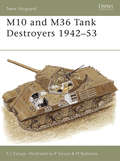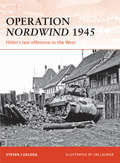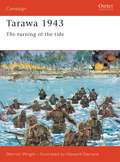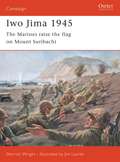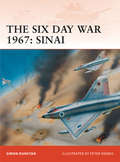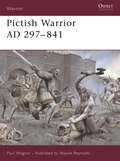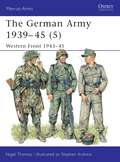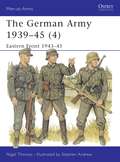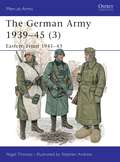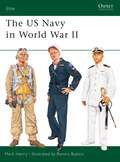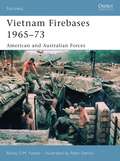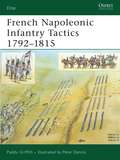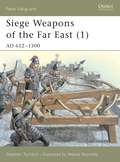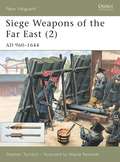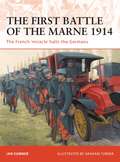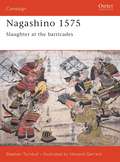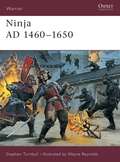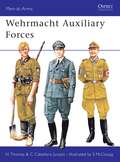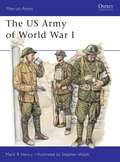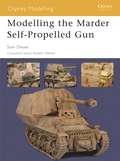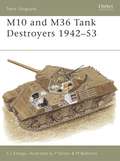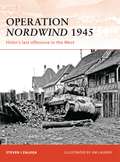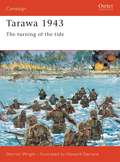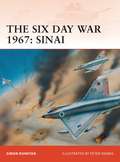- Table View
- List View
M10 and M36 Tank Destroyers 1942–53 (New Vanguard)
by Steven J. Zaloga Peter SarsonThe US Army had a unique tactical doctrine during World War II, placing the emphasis for tank fighting on its Tank Destroyer Command whose main early-war vehicle was the M10 3-inch Gun Motor Carriage, based on the reliable M4A2 Sherman tank chassis. This durable and versatile vehicle saw combat service from the North Africa campaign in 1943. By 1944, its gun was not powerful enough and it was rearmed with the new 90 mm gun, becoming the M36 90mm Gun Motor Carriage. This book details one of the only US armoured vehicles capable of dealing with the Panther and Tiger during the Battle of the Bulge.
Operation Nordwind 1945: Hitler’s last offensive in the West (Campaign #223)
by Steven J. ZalogaOperation Nordwind is one of the lesser known campaigns of World War II yet one of the more intriguing. Largely overshadowed by the Battle of the Bulge further north, Nordwind was the last great operation by the Waffen-SS Panzer divisions in the west, and the last time the Wehrmacht was on the offensive in the West. The campaign also highlights the difficulties of inter-Allied cooperation between the Americans and the French. This campaign has been extensively treated in German and French accounts, but is not well covered in English.
Tarawa 1943: The turning of the tide (Campaign)
by Howard Gerrard Derrick WrightThe island of Betio in the Tarawa Atoll was defended by the elite troops of the Special Naval Landing Force, whose commander, Admiral Shibasaki, boasted that "the Americans could not take Tarawa with a million men in a hundred years". In a pioneering amphibious invasion, the Marines of the 2nd Division set out to prove him wrong, overcoming serious planning errors to fight a 76-hour battle of unprecedented savagery. The cost would be more than 3000 Marine casualties at the hands of a garrison of some 3700. The lessons learned would dispel forever any illusions that Americans had about the fighting quality of the Japanese.
Iwo Jima 1945: The Marines raise the flag on Mount Suribachi (Campaign #81)
by Jim Laurier Derrick WrightOne of the decisive battles of the Second World War in the Pacific, Iwo Jima was described by Lieutenant-General Holland Smith, Commander Fleet Marine Forces Pacific, as "The most savage and most costly battle in the history of the Marine Corps " a titanic struggle that eclipsed all that had gone before. Situated halfway along the B-29 Superfortress route to the Japanese mainland, the island was of major strategic importance to the US Air Force, but also to the Japanese, 20,000 of whom were deeply entrenched in the island. This book provides a definitive account of the battle, from its origins to its hard-fought conclusion.
The Six Day War 1967: Sinai (Campaign #212)
by Peter Dennis Simon DunstanIn May 1967, Egypt expelled the United Nations peacekeeping forces stationed in the Sinai desert and deployed its army along its border with Israel, its moves coordinated with those of Jordan and Syria. By June, Israel realized that the international community would not act, and so it launched a pre-emptive strike against the combined Arab forces. The ensuing Six Day War was a crushing defeat for the Arab world, one that tripled the area controlled by Israel and which sowed the seeds for the Yom Kippur War of 1973 and the continuing strife in the region. Written by the author of Osprey's Yom Kippur War, this volume covers the background to the war and the campaign against the Egyptians in the Sinai Peninsula, including the initial devastating air assault that showed the world how vital air supremacy was in modern combat.
Pictish Warrior AD 297-841 (Warrior)
by Angus Konstam Wayne Reynolds Paul WagnerFirst mentioned by name in AD 297, the Picts inhabited Northern Britain from the end of the 3rd century AD to the 9th. They rose to power in the devastation following Emperor Septimus Severus's repression of the Caledonians in AD 208, and dominated Northern Britain for over 500 years, before vanishing mysteriously. The Picts represent a high point of Celtic civilisation, remaining free and unconquered beyond the borders of the Roman world, and rising to become the first barbarians to form a recognisable 'nation'. This title takes a detailed look at their origins, and examines Pictish heroic and warrior society, covering education and training, appearance and equipment, the status of women, and the experience of battle.
The German Army 1939–45: Western Front 1943–45 (Men-at-Arms)
by Nigel Thomas Stephen AndrewThis book covers the high command, the developments in unit organisation, the campaigns and the uniforms and equipment of the German Army in the last two years of the war in North-West Europe and Italy. Despite the huge pressure of fighting on three fronts, ever-worsening shortages of manpower and equipment, and Allied command of the skies, Germany's decimated divisions fought on with impressive skill and determination. This period also saw a fascinating mixture of obsolescent, newly designed, and field-made combat clothing which gave the German soldier a radically different appearance from his predecessor of just five years before. Men-at-Arms 311, 316, 326, 330 and 336 are also available in a single volume special edition titled 'German Army in World War II'.
The German Army 1939–45: Eastern Front 1943–45 (Men-at-Arms)
by Nigel Thomas Stephen AndrewIn early 1943 the annihilation of the 6th Army at Stalingrad marked the irreversible turning-point of the war in the East. Despite occasional local successes gained in the face of great odds – testimony to the Wehrmacht's extraordinary resilience – from now on Germany was on the defensive. Despite Hitler's damaging interference the quality of German field leadership, and of new weapons, remained high; but each new Soviet offensive pushed the front line closer to – and finally, across – the borders of the Reich. In this fourth title of their sequence author and artist describe and illustrate the developments in unit organization, uniforms and equipment during 1943–45, including information on European and Eastern volunteer units; text and illustrations are supported by detailed tables. Men-at-Arms 311, 316, 326, 330 and 336 are also available in a single volume special edition titled 'German Army in World War II'.
The German Army 1939–45: Eastern Front 1941–43 (Men-at-Arms)
by Nigel Thomas Stephen AndrewOperation Barbarossa, the attack on the Soviet Union, commenced on 22 June 1941. It became the biggest conflict in military history, with some three million German troops and about 900,000 allies facing almost 4.7 million Soviet troops. The effects would colour postwar European history for the next 50 years. This title examines the history of the conflict, and the organisation, uniforms and insignia of the German Army on the Eastern Front from 1941-43. The book contains numerous illustrations and photographs throughout, incuding eight fine full-page colour plates by Stephen Andrew. Men-at-Arms 311, 316, 326, 330 and 336 are also available in a single volume special edition titled 'German Army in World War II'.
The US Navy in World War II (Elite)
by Ramiro Bujeiro Mark HenryIn 1941 the US Navy had 17 battleships of which eight would be knocked out on the first day of the war four aircraft carriers, and about 340,000 men including reservists. Pearl Harbor so weakened it that it was unable to prevent the Japanese capture of the Philippines and a vast sweep of Pacific islands. By 1945 it was the strongest navy the world had ever seen, with nearly 100 carriers, 41,000 aircraft and 3.3 million men; the unrivalled master of air-sea and amphibious operations, it was poised to invade Japan's home islands after reducing her fleet to scrap and her Pacific empire to impotence and starvation. This extraordinary story is illustrated here with dramatic photos, and nine meticulous colour plates showing a wide range of USN uniforms.
Vietnam Firebases 1965-73: American and Australian Forces (Fortress)
by Peter Dennis Randy E. FosterArtillery fire support bases of the Freeworld forces played a critical role in the conduct of operations during the Vietnam War. They served to lay down high-volume fire on enemy firing sites, supported friendly infantry operations, and executed harassing fire missions where exact targets were not known. But the firebases themselves which housed a range of other facilities such as troop shelters, surveillance radars and command centers had to be defended against ground attack, and as a result became significant fortifications in their own right. This book describes the design, development and operational history of the fire support bases throughout the conflict.
French Napoleonic Infantry Tactics 1792–1815 (Elite)
by Peter Dennis Paddy GriffithBonaparte's Grande Armée, one of the most renowned battle-winning machines in history, evolved from a merging of the professional army of the Ancien Régime and the volunteers and conscripts of the Revolutionary levée en masse – although the contribution of the former is often underestimated. A leading authority on the history of tactics draws here on original drill manuals and later writings to explain how the French infantry of 1792–1815 were organized for fire and movement on the battlefield. Illustrated with clear diagrams and relevant paintings and prints, and specially prepared colour plates, this text brings the tactical aspects of eight battles vividly to life.
Siege Weapons of the Far East: AD 612–1300 (New Vanguard #43)
by Stephen Turnbull Wayne ReynoldsThe prevalence of particular fortress types in medieval China, Mongolia, Japan and Korea demanded the evolution of different modes of siege warfare in each country. The wealthy walled towns of China, the mountain fortresses of Korea and the military outposts of Japan each presented different challenges to besieging forces, and this book reveals the diversity of tactics that were developed to meet these challenges. Most of the Far Eastern weaponry of this period originated in China, but was adapted to fit the demands of siegecraft across the region and the individual strengths and weaknesses of each piece of machinery are studied here.
Siege Weapons of the Far East: AD 960–1644 (New Vanguard)
by Stephen Turnbull Wayne ReynoldsFrom the 11th century AD, East Asian armies made increasing use of exploding missiles and siege cannon to reduce the fortifications of their enemies. Some of these weapons were very similar to those used in Europe for example, the heavy siege cannon used in the siege of P'yongyang during the Japanese invasion in the late 16th century. Others, like the Korean hwach'a carts mounting over a hundred rockets that were used to bombard the Japanese at Haengiu in 1593, were very different from their European contemporaries. This book details the design and use of the wide range of weaponry available during this period.
The First Battle of the Marne 1914: The French ‘miracle’ halts the Germans (Campaign)
by Graham Turner Ian SumnerIn 1914 the Germans launched an offensive that swept through Belgium and into France, threatening to crush French resistance in one fell swoop. However, through careful maneuvering and stubborn resistance, the French Army, aided by the BEF, blunted the assault, winning an important strategic victory that kept France in the war. This victory ensured that Germany would have to fight a two-front war, and the Western Front descended into the stalemate of trench warfare. One of the most important battles in the First World War, the First Battle of the Marne would be the last battle of maneuver to be seen on the Western Front for several years to come.
Nagashino 1575: Slaughter at the barricades (Campaign)
by Howard Gerrard Stephen TurnbullWhen Portuguese traders took advantage of the constant violence in Japan to sell the Japanese their first firearms, one of the quickest to take advantage of this new technology was the powerful daimyo Oda Nobunaga. In 1575 the impetuous Takeda Katsuyori laid siege to Nagashino castle, a possession of Nobunaga's ally, Tokugawa Ieyasu. An army was despatched to relieve the siege, and the two sides faced each other across the Shidarahara. The Takeda samurai were brave, loyal and renowned for their cavalry charges, but Nobunaga, counting on Katsuyori's impetuosity, had 3,000 musketeers waiting behind prepared defences for their assault. The outcome of this clash of tactics and technologies was to change the face of Japanese warfare forever.
Ninja AD 1460–1650 (Warrior)
by Stephen Turnbull Wayne ReynoldsThe Ninja were the secret agents and assassins of feudal Japan and they remain a subject of enduring fascination. They first emerged during the power struggles of 9th and 10th century Japan, in response to the increasing demand for spies, informants and even assassins, and they were used until the mid-1600s when they disappeared on account of a campaign to destroy them. This title provides an accurate and detailed account of the reality of the Ninja, detailing their daily life, training, hiring, combat use and secret operations; also covered are the Ninja's use and knowledge of poisons, medicines and charms.
Wehrmacht Auxiliary Forces (Men-at-Arms)
by Nigel Thomas Simon McCouaigThough the 'Wehrmachtsgefolge' (Armed Forces Auxiliaries) were generally inferior to their armed forces equivalents, their contribution to the German war-effort was far from negligible. Auxiliaries including the NSKK, Transportkorps Speer, Reichsarbeitsdienst and Organization Todt supported the Wehrmacht in their duties. In 1944, the strength of these organizations peaked at 3,800,000-40% of the size of the armed forces. As they became increasingly aware of their importance, the Auxiliaries introduced uniform and insignia modifications which made them virtually indistinguishable from their comrades in the armed forces. This book examines the organization, uniforms and history of the various Wehrmacht auxiliary forces.
The US Army of World War I (Men-at-Arms)
by Stephen Walsh Mark HenryWhen the USA entered World War I in April 1917 her Regular Army counted just 128,000 men and lacked all the necessary equipment and training for modern trench warfare. By the Armistice of November 1918, General John J.Pershing's American Expeditionary Force in France had more than 2 million men and was holding 25 per cent of the Western Front. They had helped smash Ludendorff's brilliant Operation "Michael" in the lines before Paris; had turned onto the offensive themselves at St Mihiel and the Meuse-Argonne; and if Germany had not negotiated peace with unexpected speed the US Army would have taken over from their tired Allies an even greater share of the planned 1919 campaign. This concise account of America's first world class army, its organization, uniforms, weapons and character, is illustrated with rare photos and eight full color plates.
Modelling the Marder Self-Propelled Gun (Osprey Modelling #18)
by Samuel DwyerThe term Marder (meaning weasel) was the name given to this family of open-topped tank destroyers. Combining high mobility and heavy firepower, they saw significant combat action in several theatres, This book provides a detailed guide to modelling the Marder in 1/35 scale, and offers diverse challenges to modellers of all abilities. Conversions, interior detailing, kit bashing, adding aftermarket figures and parts, creating different finishes and weathering techniques are all covered in step-by-step visual detail.
M10 and M36 Tank Destroyers 1942–53 (New Vanguard)
by Steven J. Zaloga Peter SarsonThe US Army had a unique tactical doctrine during World War II, placing the emphasis for tank fighting on its Tank Destroyer Command whose main early-war vehicle was the M10 3-inch Gun Motor Carriage, based on the reliable M4A2 Sherman tank chassis. This durable and versatile vehicle saw combat service from the North Africa campaign in 1943. By 1944, its gun was not powerful enough and it was rearmed with the new 90 mm gun, becoming the M36 90mm Gun Motor Carriage. This book details one of the only US armoured vehicles capable of dealing with the Panther and Tiger during the Battle of the Bulge.
Operation Nordwind 1945: Hitler’s last offensive in the West (Campaign #223)
by Steven J. Zaloga Jim LaurierOperation Nordwind is one of the lesser known campaigns of World War II yet one of the more intriguing. Largely overshadowed by the Battle of the Bulge further north, Nordwind was the last great operation by the Waffen-SS Panzer divisions in the west, and the last time the Wehrmacht was on the offensive in the West. The campaign also highlights the difficulties of inter-Allied cooperation between the Americans and the French. This campaign has been extensively treated in German and French accounts, but is not well covered in English.
Tarawa 1943: The turning of the tide (Campaign)
by Howard Gerrard Derrick WrightThe island of Betio in the Tarawa Atoll was defended by the elite troops of the Special Naval Landing Force, whose commander, Admiral Shibasaki, boasted that "the Americans could not take Tarawa with a million men in a hundred years". In a pioneering amphibious invasion, the Marines of the 2nd Division set out to prove him wrong, overcoming serious planning errors to fight a 76-hour battle of unprecedented savagery. The cost would be more than 3000 Marine casualties at the hands of a garrison of some 3700. The lessons learned would dispel forever any illusions that Americans had about the fighting quality of the Japanese.
Iwo Jima 1945: The Marines raise the flag on Mount Suribachi (Campaign)
by Jim Laurier Derrick WrightOne of the decisive battles of the Second World War in the Pacific, Iwo Jima was described by Lieutenant-General Holland Smith, Commander Fleet Marine Forces Pacific, as "The most savage and most costly battle in the history of the Marine Corps " a titanic struggle that eclipsed all that had gone before. Situated halfway along the B-29 Superfortress route to the Japanese mainland, the island was of major strategic importance to the US Air Force, but also to the Japanese, 20,000 of whom were deeply entrenched in the island. This book provides a definitive account of the battle, from its origins to its hard-fought conclusion.
The Six Day War 1967: Sinai (Campaign)
by Peter Dennis Simon DunstanIn May 1967, Egypt expelled the United Nations peacekeeping forces stationed in the Sinai desert and deployed its army along its border with Israel, its moves coordinated with those of Jordan and Syria. By June, Israel realized that the international community would not act, and so it launched a pre-emptive strike against the combined Arab forces. The ensuing Six Day War was a crushing defeat for the Arab world, one that tripled the area controlled by Israel and which sowed the seeds for the Yom Kippur War of 1973 and the continuing strife in the region. Written by the author of Osprey's Yom Kippur War, this volume covers the background to the war and the campaign against the Egyptians in the Sinai Peninsula, including the initial devastating air assault that showed the world how vital air supremacy was in modern combat.
